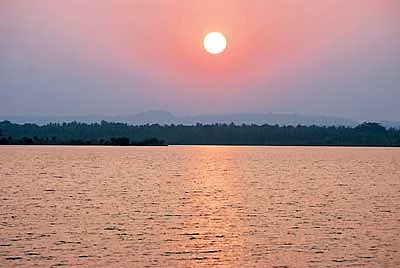

With the onset of summer, most tanks, lakes and ponds dry up, severely affecting the supply of water for drinking or cultivation. However, to augment water resources and provide a continuous supply to villages, particularly to farmers, a few dams and reservoirs have been built across rivers. Incidentally, these large water bodies not only serve their basic purpose but have also emerged as interesting picnic spots. Markonahalli reservoir beyond Kunigal is one such spot. Situated about 94 kms from Bangalore — off the national highway to Mangalore — this reservoir may not be too well known except for those visiting the revered shrine of Siddalingeshwara at Yediyur.
Beyond Kunigal, as one takes a deviation to the left and drives on, the expansive reservoir comes into view. This reservoir was built some 70 years ago under the rule of Krishnaraja Wodeyar IV to serve the irrigation needs of surrounding villages.
The Shimsha taking its origin at the foothills of the Devarayana Durga hills and flowing southward, passes through a wide plateau here. Augmented by many smaller seasonal streams and rainwater, the potential of this place as a large catchment area was visualised by Dewan Purnaiah who suggested the idea to the king.
Thus, the dam took shape in 1938. Initially, there was one sluice gate for the dam which would not hold on if there was an inundation. As it happened in the year 2000, when there was an unprecedented overflow, a part of the dam had to be broken open in order to save about 25 villages from submerging.
In later years, the reservoir was reinforced with five sluice gates and nine automatic siphons. These siphons are designed in such a way that when the water level increases above a certain limit, the air pressure created within them automatically forces open the gate. Now, the people on the leeside of the dam can live without any fear of flooding.
The dam itself runs along 138 meters but the reservoir is almost like a sea. On the other side of the bund, a tiny park has been built. The tall trees lining it, the green grass on its floor and the stone benches make it a suitable place for relaxation and a play area for children. But nothing is more soothing than taking a walk along the bund as the evening closes in.
Many birds, especially the Pied Wagtail can be frequently spotted here. Geese and coots that sail and sway with waves add beauty to the lake. As the sun dips further down, the sky begins to play with colours, changing from orange to a deep pink while the sun becomes a disc of fading golden yellow. With the silhouette of the last few birds flying across, the place paints a pretty picture. The other side of the dam with gushing waters which forms a pool, the hillock with a temple and the rural landscape, are all worth watching before you bid goodbye to this place.
How to get there
Drive on beyond Kunigal (NH48) for 17 kms to reach Hemavathy Circle and proceed on the road to the left for seven kms. Autorickshaws can be hired from Hemavathy circle or Yediyur, which is a little further. Frequent buses going from Yediyur to Nagamangala stop near the dam. Visiting Yediyur temple completes the trip.
